Are you experiencing persistent tingling and numbness into your fingers or radiating into your forearm? These are classic carpal tunnel symptoms. They begin gradually but can become persistent and more painful over time.
Although there is no single known cause, there are contributing factors like repetitive use of the hands and family history. The good news is carpal tunnel can be treated using conservative methods like splinting, bracing, medication and physiotherapy, or surgical methods.
In this article we will explore more on carpal tunnel symptoms, causes and treatment.
Table of Contents
- What is carpal tunnel syndrome?
- Carpal tunnel symptoms and signs
- Carpal tunnel syndrome causes
- Carpal tunnel treatment
- Carpal tunnel surgery
- Conclusion
What is Carpal Tunnel Syndrome?
Carpal tunnel syndrome is one of the most common nerve compression conditions of the upper limb and can lead to pain and decreased use of the hand and wrist. Often, it can start as tingling into the some of the fingers in the hand and can progress to pain in the forearm, weakness in gripping, atrophy of the muscles of the hand, and more constant pain that can impact sleep.
The nerve involved is the median nerve. It travels down the arm and into the hand through the carpal tunnel, which is on the underside of the wrist. This nerve sends signals to various muscles in the hand that are responsible for movement of the fingers in the hand (not including the pinky) and thumb.
The tunnel in which this nerve travels is narrow —about 1 inch wide. Like any tunnel, it can be crowded.[i] The median nerve, along with nine flexor tendons that pass through this tunnel, are responsible for helping your fingers bend.
These flexor tendons are surrounded with a tissue (synovium) that allow for lubrication. However, if this tissue (the synovium) swells within the carpal tunnel, it puts pressure on the median nerve.[i] This pressure or compression of the median nerve is what is known as carpal tunnel syndrome.
Carpal Tunnel Symptoms and Signs
Carpal tunnel symptoms include tingling and numbness into the thumb, index finger, middle finger and possibly the ring finger. The pain may also radiate into the forearm and begin to impact sleep (because people often sleep with their wrists bent).
In the beginning, carpal tunnel symptoms begin gradually without a specific injury and the symptoms come and go. It often starts as occasional shock-like sensations into the fingers.
Overtime, pain can be more frequent or persist for a longer time.
If the nerve is compressed for long enough, weakness and numbness in the hands is noticed where it may be difficult to hold objects or complete fine motor tasks such as buttoning up your clothes.
Carpal Tunnel Syndrome Causes
In most cases, the cause is idiopathic, meaning there is no known cause to why the swelling occurs. However, the following may be a contributing factor:
- Repetitive use of the hands (such as typing). Doing activities where the wrist is in extension or flexion for a long period of time can increase the pressure on the nerve
- Repetitive grasping movements of the hands. This can aggravate tendons of the wrist, causing swelling that puts pressure on the nerve.
- History of arthritis, osteoarthritis, or rheumatoid arthritis
- Hormonal or metabolic changes such as during pregnancy or menopause can cause swelling that results in pressure on the nerve
- Family history of carpal tunnel syndrome
Carpal Tunnel Treatment:
Bracing and Splinting for Carpal Tunnel
If diagnosed early, the symptoms of carpal tunnel syndrome can be relieved without surgery. Wearing a brace or splint will immobilize the wrist and reduce the pressure on the median nerve in the carpal tunnel. This allows for swelling to reduce. Our occupational therapist at Propel Physiotherapy is able to design and create custom splints for those with carpal tunnel.
Medication for Carpal Tunnel Syndrome
Along with the use of the brace, your family doctor might also prescribe some anti-inflammatory medication to reduce swelling. The doctor may also recommend corticosteroid injections (a strong anti-inflammatory) to assist.[ii]
Carpal Tunnel Physiotherapy
Your physiotherapist will complete an assessment that includes taking a detailed history to determine what factors could be contributing to the development of carpal tunnel. Your physiotherapist will also do a variety of tests to determine the irritability of the nerve. The assessment will help your physiotherapist to develop a customized treatment plan for you.
Physiotherapy treatment often involves a combination of manual therapy, modalities, education and/or a home exercise program:
- Manual therapy is a combination of myofascial release and mobilizations. Myofascial release is used to release the tension in the wrist flexor tendons. This to help improve some of the tension the patient might be experiencing around the wrist and help the tendons move more smoothly through the tunnel. Manual therapy also consists of mobilizations of the wrist bones (also known as the carpal bones). This helps improve the mobility of the wrist which can lead to reduced pressure on the median nerve in the carpal tunnel. Mobilizations also result in increased blood flow to the area which could help reduce pain symptoms.
- Modalities are often used to help reduce pain. Therapeutic ultrasound is often applied to the wrist and works to reduce inflammation in the area, and therefore reduce pain symptoms. Your physiotherapist may also recommend heat or ice to help with the management of pain.
- Stretching and strengthening exercises can be helpful for individuals whose symptoms are improving or are not that severe. Stretching exercises for the wrist flexor muscles would help to reduce the tension and help improve their mobility. Strengthening exercises would focus on improving the strengthen the muscles of the wrist and hand. Weakness in the hand is often a complaint and side effect of carpal tunnel syndrome, so with physiotherapy these can be strengthened to help improve your ability to complete daily tasks that require gripping and lifting. Nerve gliding exercises can also be prescribed to help the median nerve move more freely in the carpal tunnel.ii
- Education: Your physiotherapist can also help provide recommendations for activity modifications to help slow the progression of the disease. Common advice includes taking frequent breaks from repetitive lifting, grasping and typing tasks and avoiding certain tasks that could be putting excess pressure on the median nerve. Your physiotherapist can also help you to make changes to your workstation. Common modifications include ensuring your workstation is set up so your wrists are sitting comfortably on the surface and there is not any unnecessary over extension or flexion of the wrists that could be contributing to your symptoms. For more details, see post on workplace ergonomics.
Carpal Tunnel Surgery
If non-surgical treatment does not provide relief, your doctor may recommend surgery. Surgery is often used to relieve pressure of the median nerve by cutting some of the ligament that forms the roof of the tunnel to create more space in the tunnel. Recovery following surgery differs between individuals. You may need to adjust some work or home activities while you recover and begin re-strengthening the muscles in your hand – this is where a physiotherapist might be able to assist you as well.
Conclusion
At Propel Physiotherapy, our therapists have experience treating carpal tunnel symptoms using conservative methods like splinting, bracing, medication and physiotherapy, or surgical methods. If you believe you are experiencing carpal tunnel syndrome or have any questions about whether physiotherapy would be beneficial for you, please call or email Propel Physiotherapy to book a consultation or assessment.
Written by




















